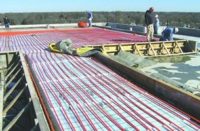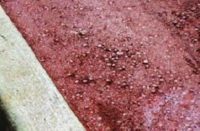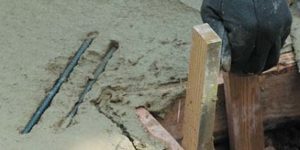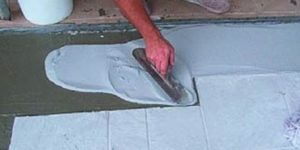
You may be enjoying the benefits of water reducers whether you know it or not. Tony Schlagbaum, group product line manager at DeGussa Admixtures Inc. in Cleveland, estimates that 70 percent to 80 percent — maybe as high as 90 percent — of concrete mixes contain some form of water reducer. And water reducers are used for good reason — they offer many benefits.

“Water reducers do exactly what the name says: They allow concrete to be mixed with less water,” observes Bart Sacco, president of Concrete Texturing Tools & Supply in Throop, Pa. In addition, water reducers can be used to provide additional workability at the same water-to-cement ratio.
The main reason to add water to concrete — above and beyond what is needed for the proper hydration of the cement particles — is to improve workability, of course. “The rule of thumb is: 0.22 to 0.25 water-to-cement ratio is required for complete hydration,” says Schlagbaum. Most mixes have water-to-cement ratios of 0.40 to 0.60 primarily for workability purposes, he adds. But keeping the water-to-cement ratio down through the use of water reducers improves the concrete’s hardened properties.
“A higher ratio of water to cement will reduce strength, durability and abrasion resistance while increasing shrinkage and cracking potential,” points out Scott Thome, director of training and product services at L.M. Scofield Co. in Douglasville, Ga. “There are numerous studies showing that properly proportioned concrete is more consistent (lower risk of variation) when water-reducing set-controlling admixtures are included.”

Sean Fallon, admixture product manager at The Euclid Chemical Co. in Cleveland, reports that “water reducers have been proven to increase compressive and flexural strengths in concrete,” though some water reducers “will not show increases until 28 days because of some initial retardation.”
Less water in the mix also means less excess bleed water. That’s another good benefit, especially for the finishers.
But how do water reducers work? How can you decrease the water and still have a workable mix?
Schlagbaum explains, “Basically, these materials work through electrostatic repulsion. All cement grains in a concrete mix have different [electrical] charges and want to come together. Water reducers give everything a negative charge and they repel each other.” This keeps the particles from agglomerating, or clumping together.
Another way to look at it, according to Fallon, is: “It is like having two similarly charged magnets that repel each other. Depending on the chemistry and concentration, this chemical attraction can wrap around the cement and create a barrier for hydration. When this happens, workability is extended and placing is improved.”

The three types of water reducers
Water reducers are divided into three general types: conventional, mid-range and high-range admixtures. While the properties of water reducers within the “conventional” category are typically very similar, the chemistries used by different manufacturers vary. Within the mid- and high-range products, not only does the chemistry vary, but the performance does, too. As Schlagbaum points out, you’re likely to see performance differences even within one supplier’s product line.
ASTM Specification C 494 Type A covers conventional water reducers. These water reducers reduce the water requirement a minimum of 5 percent. At the same time, without the addition of water, the slump is reduced 11⁄2 to 2 inches. Conventional water reducers are commonly used in everyday concrete for driveways, sidewalks, footers and basement walls.
Jumping to high-range water reducers — also called superplasticizers — this category falls under ASTCM Specification C494 Types A and F. Superplasticizers reduce the water requirement from 12 percent up to 40 percent.
“High-range or superplasticizers can be used to create a very low water-to-cement ratio for higher strength concrete, concrete with high slump, or in some cases both,” Thome says.

And, according to several experts, the technology is continuing to improve in this category.
Fallon observes, “In the old days (not so really long ago), general contractors needed to see the high-range water reducer going into the truck to make sure the slump was not achieved by water. Currently, high-range water reducers are added at the batch plant and arrive on the job site with the appropriate slump (based on specifications written for the job). If the slump is not high enough, a high-range water reducer can be added at the job site to get the right consistency for the job.”
Some of the newest formulas are based on polycarboxylate. As Sacco jests, when these superplasticizers are used in the mix you need to measure not in slump, but in spread — “it flows like pancake batter.”
![Basically, these materials work through electrostatic repulsion. All cement grains in a concrete mix have different [electrical] charges and want to come together. Water reducers give everything a negative charge and they repel each other.](/wp-content/uploads/CD/assets/Image/archives/CD406/CD0406_Concrete_water_reducers_screeding.jpg)
Superplasticizers are so important to the industry these days, Fallon adds, “A concrete manufacturer that does not use a high-range water reducer these days is like a secretary not using a computer.”
Mid-range water reducers do not have an official ASTM designation, but the “unofficial” standard is for 5 percent to 15 percent water reduction.
According to Thome, “Mid-range water reducers generally will be used when there is a desire to reduce the mix design water and increase the slump moderately.”
Fallon reports an added benefit: “Contractors appreciate the added workability and the ‘creamy’ feel which helps in finishing. Truly, the mid-range water reducers had the contractor in mind.”

At this point, it should be clear that even contractors experienced with conventional water reducers can often benefit from the other two types if a specialized project comes up.
Rick Seymour, technical services manager at Lafarge N.A. in Glenwood Springs, Colo., points out, “Mid range and high range should be used where congested rebar is an issue, superior strength (low or high slump), flowability, extra durability or workability with other chemicals is required.”
Is there a downside to water reducers?
Most experts agree with Seymour, who says, “When properly used there is no disadvantage” to using water reducers.
Water reducers are often used in combination with other admixtures, such as retarders or accelerators. When problems arise, it is frequently because some aspects of the job requirements were not factored into the choice of admixtures. Thome explains, “One example of misusing a water-reducing set-controlling admixture is the overuse of a retarding admixture. Retarding water-reducing admixtures can be employed in hot weather to slow the set and allow the contractor adequate time to place and finish the concrete. However, if the set of the concrete is extended so that the concrete remains plastic for a prolonged period of time after placement, particularly in windy conditions, the concrete is now susceptible to surface drying and a condition know as ‘plastic shrinkage cracking.’”
The solution? “Simple communication between the contractor and the concrete producer will usually resolve these issues,” Thome says.

Other problems can occur as well. Schlagbaum observes that “when you run the dosage rate too high you can delay the finishing process.” So, for instance, you may not be able to strip your forms as usual.
Another potential problem with water reducers is segregation. Use too much water reducer and your aggregate may fall out of suspension.
Benefits override added costs
When you’re talking about conventional water reducers in a truckload of ready-mix, Sacco says the average contractor won’t see the added cost. “It’s built into the price per cubic yard. The batch sizes also may be small and not add much cost to it.”
Mid- and high-range water reducers have a higher price tag, but increased strength and workability are very sellable.

From Fallon’s perspective, “Using a consistent water reducer is saving the producer money in cement and saving the contractor money. This does not always save the consumer money but it certainly helps concrete producers and contractors make a fair wage for difficult work. If you look at the price of a cubic yard of concrete, ask yourself where else you can go to get 3,500 pounds of anything for about $90 to $100?”
As Seymour sees it, “With the full range of water reducers, especially a mid-range water reducer or high-range water reducer, a contractor will most probably have a greater slump, and thus possibly could eliminate one worker to do other tasks due to the ability to move the concrete easier. With these same chemicals your strength should be accelerated, so use of the project (occupancy) can happen earlier, getting the cash flow going.”

So, with water reducers it’s really a “cost + benefits = value” equation.
Thome explains, “The true cost of concrete is not the price per cubic yard, but rather the cost of the concrete in place. The proper use of water-reducing set-controlling admixtures can greatly benefit that true ‘in-place cost.’”
Schlagbaum agrees, “Admixtures can add to the concrete cost, but a contractor must look at the total in-place cost because at the end of the day that’s what’s important; not just the concrete, but everything that goes into the job.”















